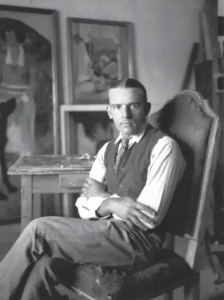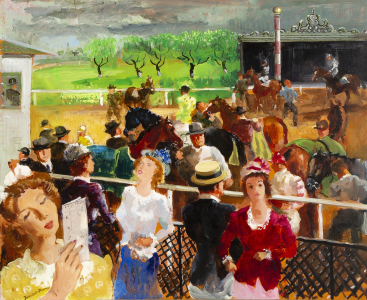
Biography
Randall Davey was probably unique in combining a passion for polo with a passion and talent for art. He was born in East Orange, NJ in 1887 and developed an early interest in art. But, at his father's urging, he went to college at Cornell, where he studied architecture from 1905-1907. He left college to study under Robert Henri at the New York School of Art, also working with Charles W. Hawthorne at the Art Students League. Henri was the founder of the Ash Can school, and Randall's associates included George Bellows and John Sloan.
In 1910 Davey exhibited with Sloan and Stuart Davis. He married Florence Nicks Sittenham the following year. She went on to appear in silent films later in the decade. Davey painted with Henri and Bellows on Monhegan Island in 1911, and he became an assistant instructor in Henri's summer painting classes in Spain. He was part of the 1913 New York Armory Show, which introduced America to modern art.
In 1915 he won prizes at the Panama-Pacific International Exposition and from the National Academy of Design. But in 1917 Davey left the United States for Cuba as part of his opposition to World War I. During the next two years his career stagnated, and he found himself at a turning point in 1919. Robert Henri had painted in New Mexico in 1916-1917 and urged Davey to make a visit to the American Southwest. So in 1919 Davey, John Sloan and their wives piled into a car and took a six-week long trip to Santa Fe.
This marked a crucial turning point in Davey's life. He and his wife saw an old sawmill on Upper Canyon Road in Santa Fe. They bought it the next year and converted it into a house and studio, where Davey lived for nearly four decades with occasional excursions to various teaching jobs. Davey did not focus on Native American themes, as did many other artists draw to the Southwest. Rather, he developed a passion for horses and polo, becoming an expert polo player himself. Many of his paintings focused on horses and the racetrack, but he also did portraits, nudes, still lifes and landscapes.
Davey taught at the Art Institute of Chicago in 1920 and at the Kansas City Art Institute from 1921-1924. In the 1930s he taught at the Broadmoor Academy in Colorado, attracted in part by its reputation as a major polo center. His salary at Broadmoor exceeded that of his colleagues, fueled by his need to maintain his polo ponies and barely tolerated by the Academy.
In 1930 Davey received a commission to do a portrait of Cyrus McCormick III, the grandson of the inventor of the reaper and a prosperous Chicago industrialist. In the course of McCormick's visits to Santa Fe to sit for Davey, he and Florence Davey fell in love. Florence divorced Randall to marry Cyrus, who also divorced his wife. This was a major blow to Randall who destroyed all of the artwork he had made featuring the beautiful Florence. Two years later Randall married Isabel Holt, a student of his at Broadmoor.
Davey completed several murals in the late 1930s and early 1940s. There were Post Office murals in Claremore, OK (1939) and Vinita, OK (1941), murals at the Will Rogers Shrine in Colorado Springs, and another mural that now hangs in the New Mexico State Capitol. He won prizes for figure painting and portraiture in 1938, 1941 and 1955. From 1945-1956 he taught at the University of New Mexico. Long an automobile enthusiast, he died in a car crash in California in 1964 when he fell asleep at the wheel.


Critical Analysis
Davey's enthusiasm for paintings of the racetrack stemmed from his desire to convey the "nervous excitement and intensity" of that milieu. He succeeds in that effort, but his portraits may be even more impressive. Their style stems from his early training with Robert Henri. But there is a degree of psychological insight in his portraits that relates to the work of his other mentor, Charles W. Hawthorne, who felt a need for painters to explore the psyche and character of their subjects. The combination of Henri's style and Hawthorne's depth fused to produce some of Davey's remarkable portraits.
Murals
- Santa Fe, New Mexico - New Mexico State Capitol: Polo Ponies
- Claremore, Oklahoma - Post Office: Will Rogers
- Vinita, Oklahoma - Post Office: History of the Cherokee Nation
References
- Florence Sittenham Davey (Mrs. Randall Davey), 1914 (National Gallery of Art).
- History of the Cherokee Nation (National Postal Museum).
- Paul Weideman, The Interior World of Painter Randall Davey, Press Reader: Pasatiempo 27 September (2019).
- The Quintessential Modernist, Matthews Gallery Blog March 28 (2015).
- Randall Davey (artcloud).
- Randall Davey (Missouri Artists).
- Randall Davey (Nedra Matteucci Galleries).
- Randall Davey (askART).
- Randall Davey (Wikipedia).
- Randall Davey (Modernist West).
- Randall Davey (Olympedia).
- Randall Davey (American, 1887–1964) (artnet).
- Mae Sander, Randall Davey, Santa Fe Artist, Mae's Food Blog April 28 (2022).
- Randall Davey: Explore an Artist's Legacy (Santa Fe).
- Randall Vernon Davey (1887-1964) (Taos and Santa Fe Painters).